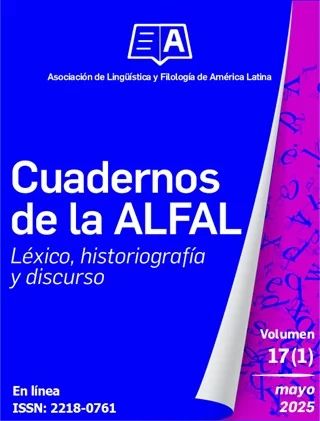Variation in the union and separation of the “preposition + complement” structure in the written spanish from New Spain (16th–18th centuries)
DOI:
https://doi.org/10.5935/2218-0761.20250007Keywords:
written Spanish, preposition+complement, nonliterary scribes, New Spain, blank spaceAbstract
This article examines the variations in the writing of prepositions in manuscripts of the three centuries that encompass the period of New Spain. The main goal is to describe the variations in the presence vs. absence of a ‘blank space’ in the structure of preposition+complement. The original sources are text transcriptions done by nonliterary scribes from New Spain in the 16th, 17th, and 18th centuries. These documents constitute the corpus which includes 60 documents that proceed from several collections of public and private documents. According to the quantitative analysis which is based on the averages of the union vs. separation, the contrast between the sociocultural and literacy parameters reveals that the variable use of a 127 space was generalized, independently of the scribes’ degree of writing proficiency. Instead, the chronological variable did have an influence on the standardization of the dividing space.
Downloads
References
Arias Álvarez, Beatriz. 2014. Documentos públicos y privados del siglo XVI. Textos para la historia del español colonial mexicano I, Ciudad de México, Universidad Nacional Autónoma de México. Báez, Gloria. 2009. Del catecismo a los libros de texto gratuitos. Un panorama histórico de la enseñanza del español en la escuela primaria, en José Moreno de Alba (coord.), Historia y presente de la enseñanza del español en México, Ciudad de México, Universidad Nacional Autónoma de México: 13-186. Eberenz, Rolf. 2009. La periodización de la historia morfosintáctica del español: propuestas y aportaciones recientes, en Cahiers d’Études Hispaniques Médiévales. N°32 (pp. 181-201). DOI: https://doi.org/10.3406/cehm.2009.2072. www.ersee.fr/doc/cehm_17794684_2009_num_32_1_2072. Ferreiro, Emilia y Clotilde Pontecorvo, 1996. La segmentación de las palabras gráficas, en Emilia Ferreiro et al. Caperucita roja aprende a escribir, Barcelona, Gedisa. Hidalgo, Antonio y Mercedes Quilis. 2002. Fonética y fonología españolas, Valencia, Tirant lo blanch. Iciar, Juan de. 1555. Arte subtilissima, por la qual se enseña a escreuir perfectamente / hecho y experimentado, y agora de nueuo añadido. Edición facsímilar. Juan Pablo II. 1995. Encíclica Evangelium Vitae, disponible en (https://www.vatican.va/content/john-paulii/es/encyclicals/documents/hf_jp-ii_enc_25031995_evangelium-vitae.html). Lafaye, Jacques. 2002. Albores de la imprenta. El libro en España y Portugal y sus posesiones de ultramar (siglos XV y XVI), Ciudad de México, Fondo de Cultura Económica. Olson, David. 1995. La cultura escrita como actividad metalingüística, en David Olson y Nancy Torrance, Cultura escrita y oralidad, Barcelona, Gedisa: 333-357. Oesterreicher, Wulf. 2001. La ‘recontextualización’ de los géneros medievales como tarea hermenéutica, en Johannes Kabatek (ed.), Lengua medieval y tradiciones discursivas en la Península Ibérica: descripción gramatical; pragmática histórica; metodología, Madrid/Frankfurt am Main: Iberoamericana/Vervuert Verlag: 259-298. Quilis, Antonio. 1999. Tratado de fonética y fonología españolas, Madrid, Gredos. Rodríguez, Josafat. 2024. Unión y separación de palabras en escritos novohispanos: su estudio desde la sociofilología, Ciudad de México, Universidad Nacional Autónoma de México. Tesis doctoral- Inédita. Saenger, Paul. 1997. Space between words. The origins of silent reading, Stanford, Stanford University Press. Salinas, Miguel de. 1563. Libro apologetico que defiende la buena y docta pronûciaciô q guardarô los antiguos en muchos vocablos y accentos, con las razones que tuuieron y ay para se tener, que fue buena y sabia, y no ignorante ni mala, segû que algunos delos modernos hâ reprehendido y condenado…. Edición facsímilar. 147 Sánchez-Prieto Borja, Pedro. 1998. Fonética ordinaria y fonética de la lectura en la investigación sobre los textos castellanos medievales, en Giovanni Ruffino (ed.), Atti del XXI Congresso Internazionale di Lingüística e Filologia Romanza (Centro di studi filologici e linguistici siciliani), Universtà di Palermo, 18-24 settembre 1995, Tubinga, Max Niemeyer Verlag: 455-470. Villalón, Cristóbal de. 1558. Gramática castellana. Edición facsimilar.
Downloads
Published
How to Cite
Issue
Section
License
Copyright (c) 2025 Cuadernos de la ALFAL

This work is licensed under a Creative Commons Attribution-NonCommercial-NoDerivatives 4.0 International License.
You are free to:
- Share — copy and redistribute the material in any medium or format
- The licensor cannot revoke these freedoms as long as you follow the license terms.
Under the following terms:
- Attribution — You must give appropriate credit , provide a link to the license, and indicate if changes were made . You may do so in any reasonable manner, but not in any way that suggests the licensor endorses you or your use.
- NonCommercial — You may not use the material for commercial purposes .
- NoDerivatives — If you remix, transform, or build upon the material, you may not distribute the modified material.
- No additional restrictions — You may not apply legal terms or technological measures that legally restrict others from doing anything the license permits.
Notices:
You do not have to comply with the license for elements of the material in the public domain or where your use is permitted by an applicable exception or limitation .
No warranties are given. The license may not give you all of the permissions necessary for your intended use. For example, other rights such as publicity, privacy, or moral rights may limit how you use the material.















